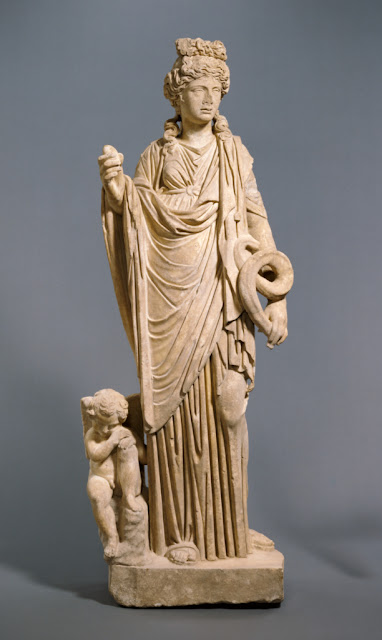Salus, personification of the security and welfare of the Roman people
Salus, personification of the security and welfare of the Roman people, 200-250 CE
Salus was the Roman personification of health and well being, and came to be very closely associated with the Greek goddess Hygieia, the daughter of the healing god Asclepius. She is often represented in works of art with the same attributes as Hygeia – in particular both are frequently depicted with a snake wrapped around one arm. However, they each kept their own separate identities, and served very different functions. While both deities protected individual health, Salus was also responsible for the prosperity of the Roman state and its rulers. In this regard, she personified the security and welfare of the Roman people, and was therefore an especially important deity for the city of Rome. She had a temple and cult on the Quirinal Hill in Rome, and various representations of the goddess appeared on Imperial Roman coins. Because the Getty’s statue is close to life-size, it may have been a cult image that was set up in a public space or a temple. In this setting she would have represented public welfare. Smaller versions of Salus, however, were often set up in domestic spaces and private shrines, where an individual could offered prayers for personal health.
This statue is unique in that the attributes of Salus – the snake and the egg – are combined with images commonly associated with Venus (Greek Aphrodite), the goddess of love. Here Salus is accompanied by Cupid, usually a companion of Venus. Her hairstyle tied in a bow on top of her head is also characteristic of Venus. However, unlike Venus, who is often depicted nude, Salus is represented as a heavily draped goddess. It was not uncommon for Roman goddesses to use a combination of attributes from different deities. Salus was sometimes depicted with a rudder and a globe, which were typical attributes of Fortuna, the goddess of Fortune. However, this statue is the only known example in which Salus and Venus are paired together. - J. Paul Getty Museum
Image: Salus, personification of the security and welfare of the Roman state, 200-250 CE, courtesy of the Getty Museum




Comments
Post a Comment